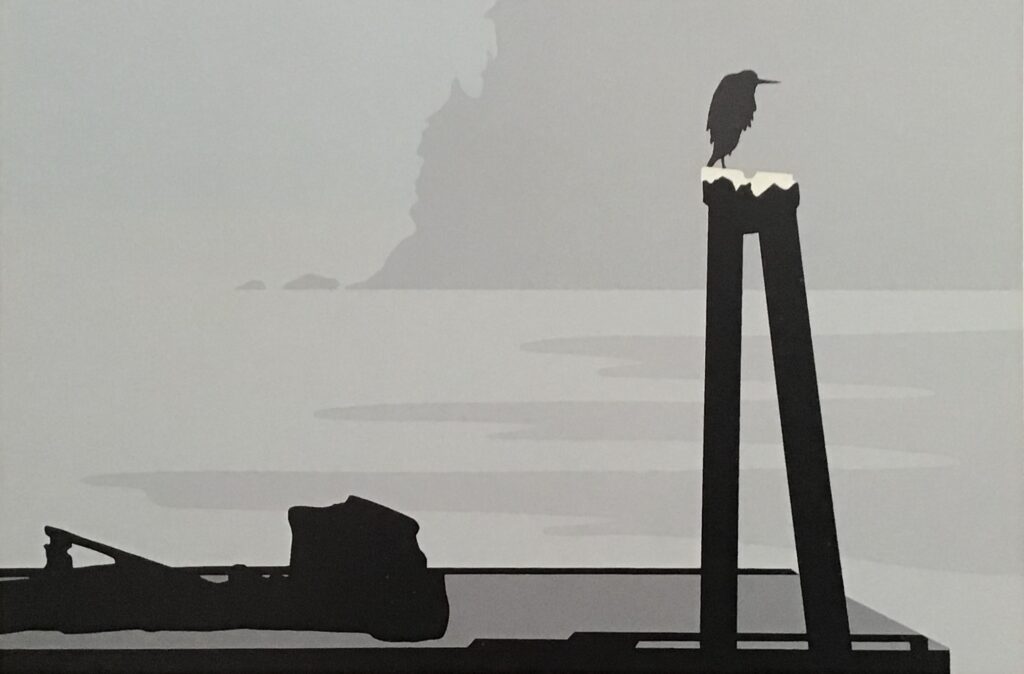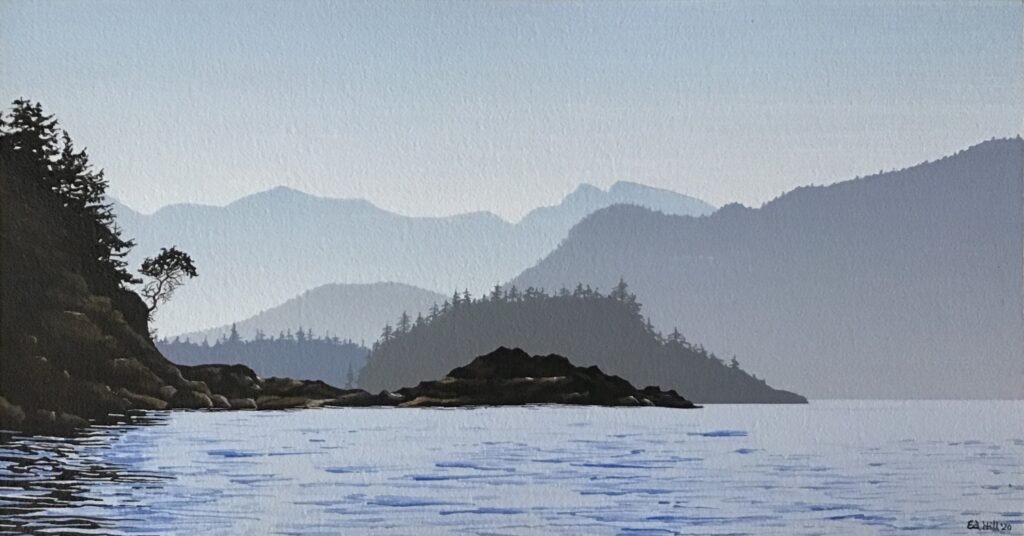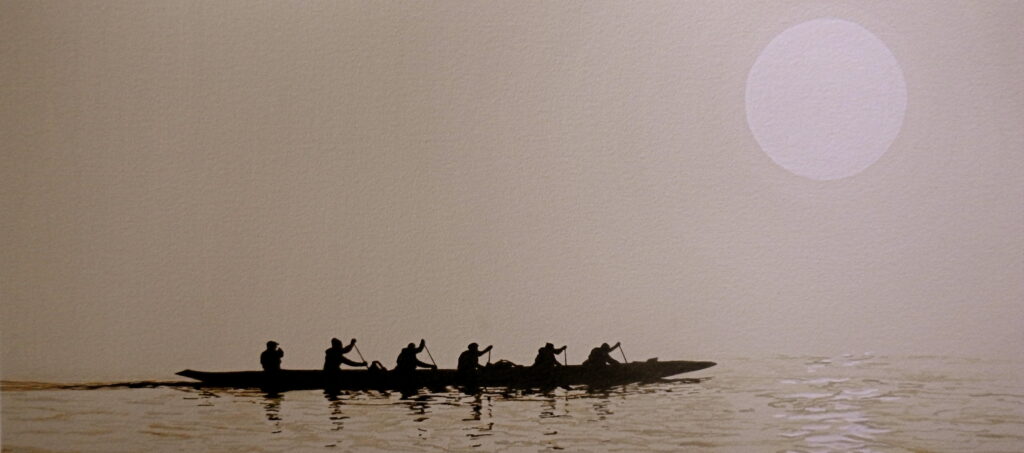Kill Zoners — It’s my pleasure and privilege to welcome a great guest to our blog. Ed Hill is a prominent Canadian painter and storyteller. He’s a prolific artist and writer who’s guided me as a life mentor and protected me as a police colleague to which I’m forever grateful. Please welcome Ed Hill to the Kill Zone.
— —
Garry Rodgers and I have been friends for well over 40 years. When he asked me to submit an article for The Kill Zone, I was well aware my thoughts would be read by any number of accomplished novelists. While I consider myself a writer, particularly within the realm of my discipline of being an artist, I could find writing in such company as this, a bit intimidating.
But I don’t. My writing is about emotion, spirit, energy, and a very direct link to my artistic creations in the form of paintings. As I finish a painting, my work is only truly completed when I “paint” the final bit with words.
You see I’m a painter first, and being a writer is but a part of my artistic expression. A bit of history will help explain. In the mid 1980’s, in the middle of a 34-year Royal Canadian Mounted Police (RCMP) career, my painting journey began. I was taught by an indigenous artist. And as such, much of what I learned was from the indigenous perspective.
It was from those origins that I found the value and reality of writing a story with each painting. A visit to my website www.edhillart.com will show that each image has a story, and that story is as much a part of my painted creation as the painting itself. In fact, whenever I sell a piece of my work, the story is always attached. I tell anyone who owns a piece of my work that unless they know the story of the image, they only have half of my artistic creation.
I suppose a bit of cultural history might be in order here. Within the indigenous culture virtually every painting, sculpture, totem pole, beadwork, or song has a story. Just ask. Within the very natural surroundings that we all live in, the indigenous culture has a story. And so, from the origins of my painting career my indigenous teacher, Roy Henry Vickers, taught by example. Every painting he does is accompanied by a written story.
When I started painting in 1985, I wrote a story with the very first image I created. You’ll find the image of my first painting at my website under the title of “Old Man”. And ever since, every painting I’ve done has a story. Some are emotional. Some are poetic. Some are a protest. And some can even evoke a spiritual connection for the reader.
The painting and the very act of creating it dictate what the story will be. Indeed, over the years I’ve written so many stories that they could be compiled and published as book themselves. Some people in fact have told me that they have used my website as a “book” while they’ve taken the time to view the paintings and read the hundreds of stories attached.
As I have taught my painting techniques to many artists over the years, I’ve always touted the value of composing a story to be a part of their painting I’d be generous in saying that perhaps 5% of my students practice that teaching. So many find it hard to express their thoughts and emotions.
As any of you reading this article know, it takes discipline to sit down and write. Not everybody has the commitment, energy, creativity or that unique and special discipline to be a writer. As the old saying goes, “If it was easy, everybody would be doing it.”
As writers, I know you write from experience, but you also create from emotion, from a place of energy and creativity. You write from an inner need to get it out there. When that writer within has a story to tell, your inner muse is always calling to you. And so it is with me as an artist.
When I have a painting in progress, I often tell my wife as we are away from my painting, that I can “hear it calling to me”. And therein lies the story. You see, for me, the story develops and reveals itself as I paint. Seldom do I paint an image with the title and story realized ahead of time. In the many hours of painting, lost in the Zen of creativity, I let my brain wander. I may be painting an image I’ve seen for decades, yet now I have chosen to paint it.
Why?
Why now?
That’s when the story begins to whisper. And as I paint and compose the image, so too the words of my story flood my brain. Hard to explain, the story comes in an inspirational, creative, and even a “spiritual” surge from within. I’m not overstating that. The story comes from the very spot within me that the painting comes from. It’s a part of my artistic creation. When composing my story, as I write, I paint with a palette of words.
Sometimes the title is evident almost immediately. Other times, only as the paint dries and the words of my story turn into sentences does the title take shape. And when it does, the title in particular is compelling. It must be.
Titles such as “Get Over It”, or “Covid Blue” are good examples of that. To understand those titles, you have to read the story. And when you read the story, you’ll then refer back to the painting. The energy of that loop is complete.
The image is the very first contact anyone usually has with my creative expression, but the title is what turns their gaze to the story. And I’ve watched from afar at shows where someone will study my painting, turn to the story, then back to the image with their eyes opened to the very intention and spirit of the painting. And speaking commercially, quite often it’s the story that connects the viewer to the image, and that results in a sale.
Often, I can sit in my home with a coffee and just revisit the many paintings I have hanging on my walls. I’m always taken back as to the “why” of a particular painting. I marvel at the very creation, and many times realize I could never do that painting as well were I to try it again. That painting was a product of a moment in time, a moment charged with circumstance, serendipity, and emotion.
I “use” my paintings a lot for that purpose. I find a soothing comfort in just revisiting them and savouring the colour, composition, light and dark, and very presence of the image itself. But so too, I will read the story attached just as often. Those words painted into the composition of the story have an everlasting energy. It’s an energy that never grows old.
My family have instructions. When and if my time comes to be in a bed someday as I approach the end of my life’s journey, they’re to read to me. They’re to read those stories of emotion, spirituality, and creativity. For those are the touchstones of my life.
I know those words, even if my eyes are closed to the paintings themselves. I know too that those words will resonate with a positive energy that’ll have some meaning and comfort to me. When the lights do inevitably go out, it’s those words that I want to take with me.
I close these thoughts by referring the reader to one of my paintings titled “Forever”. I think the story of “Forever” applies to my written words. And so too to yours. Created with our energy and inspiration—as writers—our words will long outlive all of us. They are FOREVER.
— —
Bio — Born in Paris, Ontario in 1948 and later moving to Peterborough, Ed Hill’s journey to becoming a distinguished artist began in earnest after a career in the Royal Canadian Mounted Police, which he joined at age 20. His artistic ambitions, which had been a mere dream since his high school days, began to crystallize in the mid-1980s after moving to Tofino, British Columbia, and meeting the renowned artist Roy Henry Vickers.
Under Vickers’ mentorship, Hill honed his skills and developed a distinctive style, producing his first notable work, “Old Man.” His art, deeply inspired by the landscapes of British Columbia, seeks to evoke the profound emotions tied to the region’s natural beauty.
Now retired and living in Gibsons, British Columbia, with his wife Joy, Hill continues to explore and depict the “West Coast” essence, aiming to capture the moments where nature and the observer’s inner world harmoniously align, hoping his viewers anywhere can feel the unique “music” of British Columbia’s landscapes through his work. Visit www.edhillart.com.
— —
Kill Zoners — Painting with words. How does this resonate with you? Do you “see” your writing as it’s imagined and unfolds? Could you captivate your story in one image as Ed does with his? Let’s discuss, and please share how you paint with words.






Welcome, Ed, and thank you, Garry, for inviting him.
I often think of writing as a form of music, but you’ve given me another way to view it. I’ll have to put some thought into an image for each of my works.
I love the paintings. One question: what medium do you use?
Good morning from Gibsons, British Columbia Kay. And thanks for your comments and question.
Music, image, or the lilt of a piece of poetry, or a novel that catches my attention, for me it’s all about the energy or spirit. And I’m glad if my words and images have given you another way to feel that vibe from within.
As to the medium I use, I continue to use the same medium today as I started with all those years ago. I paint with watered down acrylic on 300 lb Arches, cold press paper. Many acrylic painters are surprised to see that in my work, but for me it’s very familiar and comfortable.
Thanks for this, Garry & Ed!
I’m noodling a new novel in my head (or . . . I guess it’s the characters noodling me up there . . .), and often I see them like actors on a set. I see colors, hear the wind, angry folks yelling at each other, and feel their tears on my face. I think it’s a story I must tell.
I’m going to keep watching their landscapes and *paint* the pictures in my mind, Mr. Hill. (My mother was the artist in the family and I did not get that gene.)
I checked out your website. I’ll be back there again soon.
You two have an awesome day!
Good morning Deb. I read your comments with interest.
I’ll disagree with you in terms of you not getting the “artist” gene. From my personal experience, both the writer and the painter come from exactly the same place in my spirit. That energy merely expresses itself in one way or the other. I know this to be true because my “time” to be creative can go either way on a given day. Even as I write this to you, it’s being done at exactly the time my painting is calling to me. It’s that energetic, creative spirit from within allowing me to work at this moment.
And my bet is that you could unleash the artist (painter) from within. I’ve taught many students who claimed they couldn’t draw the proverbial stick man before. And now they are expressive, creative painters.
I hope you enjoy my website, in particular as a writer relating to the images I’ve created.
Thanks for learnin’ me, Mr. Hill!
I never leave TKZ empty-brained or empty-souled.
My mom used to say it was harder to draw a stick man than a whole landscape, because she couldn’t visualize a real person as a stick.
She was a wise woman, that mom…
Thank you again for your encouragement.
Welcome, Ed! Your paintings are so evocative, to say they hint at a story would be an understatement—they are clearly filled with story.
Words in my own fiction are filled with dramatic energy which evokes imagery, emotion, character. I don’t paint with words as such, rather, it’s about spinning an immersive narrative. It comes together as a movie-like experience, only much is internal to the POV character, and much resonates through dialogue.
Summing up one of my novels in a single image is an interesting idea. In a sense, one could look at my covers as that, only it’s my designers who created them.
You’ve given us a lot of food for thought today. Thank you!
And thank you, Garry for inviting your friend here today!
Hi Dale,
I had a look at the book cover of Shush Before Dying and I can certainly see what must be the summation of the storyline.
It’s interesting to me in that years ago I designed a book cover for a local author, and I didn’t enjoy the experience. I found I was painting to someone else’s expectations. Technically, the image was fine. It told the story for the author. But, I got virtually no artistic energy out of the creation of the piece, or the finished product.
On the other hand, twice I’ve had musicians contact me and ask if they could use one of my images for their album cover. Why? Because the particular image they’d seen of mine evoked the emotion of their music. Now that’s when the two artists, the musician and the painter, come together. That was satisfying on both counts, and I’m proud to see that image in that context from time to time. I’ve even had a brewery contact me to use my images on a couple of limited edition brews. Happily I allowed that to happen, but had they asked me to design one, I probably would have turned it down.
I hope all that makes sense. But for me, it’s all about the positive creative energy coming from within.
And the Kill Zone comments on the WordPress platform are doing their thing again – all the ones from earlier this morning on this piece have vanished. This is bloody frustrating, never mind being professionally embarrassing. I’d apologize, folks, but I have no control over this.
Oh no, Garry. Do you have mine? It was rather long. 😉
Ack!!
I’m not going to let this thing beat us. I’ve gone into my email and retrieved some of the earlier comments. This one from Debbie Burke:
Garry, thanks for introducing TKZers to Ed Hill. Ed, I’m in awe of how
you combine visuals and words. Great blending of lovely images and the
stories behind them.
Capturing a story with a single image is way beyond my talent. That’s
why cover artists are needed.
Many authors visualize scenes as if they’re watching a movie.
Unfortunately I don’t have that gift. Rather, I home in on a few
select details in a scene, the way a character moves, the way the
setting reflects the action, the way dialogue is spoken. If I choose
specific, effective details, the reader’s imagination can fill in the
rest.
Thanks, Garry and Ed!
Garry, I’m replying here as I didn’t get Debbie’s original message. Please be sure it gets to her.
Hi Debbie,
Thanks for your comments. If you’ll refer back to my comments to Dale Ivan Smith you’ll see I wrote about my thoughts and experiences as a “cover artist”.
Debbie, somehow your comments took my mind to “What came first, the image or the story?” I don’t know how it is with you personally, but for me, somehow life, circumstance and emotion all play a role as a painter. The very “vibe” I’m feeling on a particular day can bring me to a full stop on some shoreline of the Salish Sea. The image of the moment resonates with my emotions of the day and becomes compelling. It must be painted.
Other times, I’ll find an artistically pleasing scene and know I should be painting it. Without knowing the “why”, the process begins. But then, as the painting develops over the next 2 or 3 weeks the emotion and energy turn into words, and the story is born.
I hope all that makes sense, and that it’s not too “artsy”, but for me it really is that way. Thanks for evoking those thoughts today.
Hi Garry and welcome, Ed!
Interesting topic. And answering Garry’s question: Yes, I certainly “see” my writing as it unfolds. In fact, it starts long before that when I’m working on the Concept, then the Premise, and finally, the Writing. I’m watching the movie of the evolving story playing out behind my eyes. And because I also design my own covers, that single image (which also evolves during the process) does kind of summarize the entire story.
TO ED: I checked on your site—wonderful work!—and I notice that you also do limited-edition “giclées.” You may be interested to know that I’m a bit of an expert on that subject and actually know the man who coined that term. And no, he’s not French, but there’s French language involved in that origin story. I can fill you in more, if you’re interested. Just google and reach out to me if you want.
Thanks for the offer Harald. Yes, I’ll contact you. It turns out apparently that I’ve been teaching the wrong thing about giclée all these years. Cant’ wait to hear the real story.
This one was from me:
Thanks so much for writing this great piece, Ed, and for sharing your
world – very informative and heartfelt. I’m curious and I don’t think
we’ve ever discussed it (and expanding on Debbie’s comment and I’m
sure others here are wondering the same thing) – from your perspective
as a visual artist, what makes for an effective book cover?
Hi Garry,
My previous words to Dale Ivan Smith speak somewhat about book covers and my experience with them.
I suppose, unless the writer creates their own image for the cover, that most book covers are in effect – commissioned works. And that’s where I get off the bus. I’ve done few commissions in my artistic career. Only a few that I consider pieces I enjoy.
From an artist’s vantage point, I see book covers as being one of two presentations. The first image would be that of telling the story in some visceral or cryptic fashion. Apparent, or hidden within the cover image would be some reference to “the story”.
The other type of cover image would be one that creates an energy, a spirit or vibe in reference to the content of the book. Colour, composition, contrast, movement and drama in an image can all evoke emotional response to the viewer. And all that can be done without an actual recognizable image. And that cover method speaks more about the vibe of the story within. It speaks about “the energy”. And if that energy resonates, chances are the viewer just might pick up that book.
And from Sue Coletta:
Ed, your passion bleeds through your words. I felt every emotion — a
sure sign of a great writer. Your art is equally impressive. FOREVER
looks like a photograph, it’s so well done. Love that you had a Native
mentor. Probably why your art speaks to me.
Garry and I connected over a decade ago through his blog. When I
received his book of crime tips for signing up, his passion resonated
with me. So, I emailed him. We’ve been best buds ever since.
To answer the question posed… I don’t paint, though the covers of my
novels could fall under a similar category. I spend a lot of time
designing each one, which I then describe in words for my cover
artist, along with a slew of links to sample images for each piece of
the design. After we go back and forth with tweaks, the end result
matches my mental image and represents the story inside.
Welcome to TKZ, Ed. Pleasure “meeting” you.
Garry, again, can you please be sure Sue gets this response.
Hi Sue from Gibsons, British Columbia
I Googled your website Sue, so I got to see the great work your artist(s) do in creating your covers. They certainly evoke a suggestive energy. I so admire those artists who can “translate” from one person to another and capture what the client wants and expects. That’s a special talent.
If ever you’re checking out artist’s works, no matter where you might find them, and you see an image that jumps at you in terms of energy, vibe or even story, don’t ever reject the idea of contacting that artist to see if you can use it. Sometimes the universe sends opportunity your way. There’s certainly no loss in contacting an artist and at least discussing. You’ll never know what serendipity may be gifting you.
Thanks for your comments.
From Grant Furguson:
Thanks for the inspiration, Ed. Long ago, I heard the 500 most used
words in the English language have over 5,000 different meanings,
connotations, and inferences; thus, our choices set the tone and
materially influence the word pictures we paint.
Thanks for the comments Grant,
What applies to words, also applies to colour. A skilful choice of words and phrases can create a story that energizes the reader and evokes emotion.
So too, as painters, our colours, in conjuction and in contrast with each other, can achieve exactly the same effect. We are all artists, us painters and writers, we just have different mediums.
Thanks Garry, for reposting the earlier comments from Debbie, Sue, Grant–appreciated being able to read them.